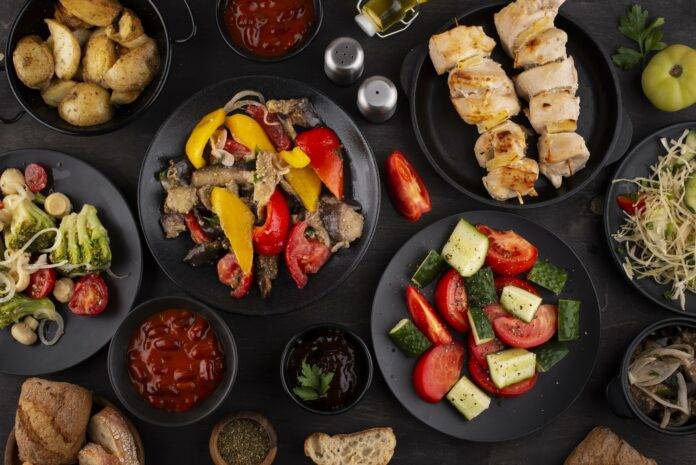Table of Contents
The culinary scene is no exception in a world where the fusion of cultures is becoming increasingly prevalent. Food fusion, the art of blending culinary traditions and techniques from across the globe, has risen as a hallmark of global interconnectedness and human creativity. By taking a closer look at this cross-pollination of flavors, we can explore the many tastes that tantalize our palates and the essence of what it means to unite and understand each other through something as universal as food.
Introduction
Imagine feasting on a plate of bulgogi tacos or savoring a slice of sushi pizza. These examples of food fusion are not just the imaginings of some chef’s fever dream—they’re natural culinary marvels that blend the best of multiple worlds into one delicious bite. This phenomenon of culinary blending, also known as ‘fusion cuisine,’ is all about mixing ingredients, flavors, and techniques to create dishes that honor the origins of their individual parts while producing something exciting and new. In this article, we’ll serve up a feast of understanding about food fusion and the delightful impact it has on our global palate.
Exploring Food Fusion
Understanding where food fusion comes from is like tracing the steps of a revolutionary who didn’t shack up in the history books because they preferred being in the kitchen making magic. Fusion cuisine has its roots as early as the 1970s but didn’t truly take root until the 80s and 90s when chefs—inspired by travel, immigration, and a thirst for adventure—began pushing traditional dishes’ boundaries.
Today’s fusion cuisine has traveled far beyond the initial experiments. It has become a cultural melting pot, combining elements from every continent and creating cross-cultural experiences that extend far beyond the plate. This has expanded the options for dinner and given rise to some of the world’s most innovative and beloved dishes.
Benefits of Food Fusion
The amalgamation of culinary traditions does more than produce some Instagram-worthy dishes. It also acts as a conduit for cultural exchange, fostering unity and breaking down the walls that separate us. The benefits of food fusion are as rich as the dishes it creates, and they’re just waiting to be savored.
Culinary Creativity and Innovation
The heart of food fusion is creativity. It’s the backbone that reaches across traditions and allows cultural cross-pollination. Chefs become culinary ambassadors, not just of their native cuisines but also of the fusions they create. By experimenting with new combinations, they give birth to tastes that defy expectations and write new stories with every bite.
Cultural Exchange and Appreciation
Food is a language everyone speaks, a universal means of communication conveying love, respect, and shared experiences. When we appreciate and enjoy a fusion dish, we’re not just eating; we’re conversing silently with another culture. It’s a celebration of diversity that broadens the mind and the heart.
Taste Exploration and Diversity
Food fusion is for more than just the daring diner. It’s for anyone who relishes exploring new flavors and experiences. By blending the familiar with the foreign, fusion cuisine presents an all-you-can-taste buffet of diversity, expanding personal palates and horizons.
Examples of Food Fusion
From the avant-garde to the every day, food fusion takes many forms. Here are some popular dishes that have become symbols of the power of culinary fusion:
Famous Fusion Dishes
Think of the cronut, the taco al pastor, the Hawaiian poke bowl, and the Indian butter chicken pizza. These dishes have become sensations, each in their own right, by combining the best culinary elements of their respective cultural backgrounds. They’re more than just food; they’re ambassadors for the idea that blending cultures can result in culinary greatness.
Unique Cultural Blends
Beyond the fame, countless other fusion concoctions are waiting to be discovered. Have you heard of Korean-style burritos or an Italian-Japanese fusion resulting in a plate of wagyu beef carpaccio with a salmon roe and miso vinaigrette? The list goes on, as endless as the imagination of the chefs who craft these cultural hybrids.
Impact on Food Enthusiasts, Culture Lovers, and Travelers
Food fusion has an indelible impact on the foodie, the lover of culture, and the traveler. It opens the door to a world of flavors, experiences, and connections that can otherwise be hard to find.
Enhancing Culinary Experiences
Food fusion is a treasure trove for those who live for culinary adventures. It adds an element of surprise to dishes and dining experiences, making every meal an event. From food trucks to five-star restaurants, there’s no limit to where food fusion can take the palate.
Bridging Cultural Gaps
A Thai green curry might seem light years away from an American burger, but in a fusion dish, the distance between worlds shortens. Eating a dish that combines these flavors is akin to experiencing a cultural handshake—a moment where two seemingly disparate cuisines meet and find common ground.
Inspiring Travel Through Food Exploration
It’s often said that the best way to understand a culture is through its food. For many travelers, food fusion has become a roadmap of sorts, guiding them through global flavor territories without the need to pack a single bag. By exploring fusion dishes, they’re traveling the world one meal at a time, and with each bite, they’re gaining a deeper appreciation for our planet’s rich tapestry of cultures.
Conclusion
Food fusion is a tale of people coming together, sharing their passion for food, and building bridges between cultures. It’s about acknowledging the beauty of difference and rejoicing in the richness that diversity brings to our tables. We might not solve the world’s problems over a plate of Korean taco nachos, but we’ll come a bit closer to understanding that, at our core, we’re not so different after all. When it comes to blending cultures, one dish at a time, the results are not only delectable but also remind us that no matter how far apart we might seem, we’re all just neighbors in this global kitchen.





